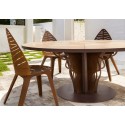1. Durability and resistance to atmospheric agents
One of the main advantages of metal street furniture is its incredible resistance over time. Unlike materials such as wood or plastic, which can deteriorate more quickly due to exposure to atmospheric agents, metal is much more resistant to corrosion, temperature changes and bad weather.
The ability of metal to withstand difficult climatic conditions makes it ideal for benches, lampposts, bins and other furniture elements that must be constantly exposed to the open air
Metal alloys, such as stainless steel or aluminum, are particularly resistant to rust and wear, thus prolonging the useful life of street furniture. In addition, specific treatments such as powder coating or galvanizing can further increase the resistance of metal.
2. Low maintenance
Metal requires relatively low maintenance compared to other materials. While wood, for example, may require regular treatments against rot or discoloration, and plastic can fade or break easily, metal retains its integrity over time with little intervention.
Furthermore, any damage is easily repaired, either by replacement or by polishing or repainting. This makes metal an economical and practical choice for local governments and companies looking to invest in long-lasting solutions.
3. Versatility and design
Metal is a highly versatile material that allows for great creative freedom in design. It can be modeled in various shapes, sizes and styles, making it suitable for different urban contexts, from city centers to peripheral areas.
The modern and minimalist design of metal structures easily adapts to contemporary environments, while metal can also be used to recreate more traditional styles, thanks to processing techniques that allow for high-quality aesthetic finishes.
Furthermore, it can be combined with other materials such as glass, wood or stone, creating urban furniture that responds to specific aesthetic and functional needs. The use of metal also allows for the creation of light and elegant shapes, minimizing visual bulk while maintaining the necessary robustness.

4. Sustainability
In an era in which sustainability is a central theme, metal also stands out for its relatively low environmental impact.
Unlike many synthetic materials, metal is completely recyclable, reducing the burden on the environment and contributing to the circularity of materials. The production of metal street furniture, especially if made with recycled alloys or through low-impact processes, represents a responsible choice for cities that want to invest in greener solutions.
Furthermore, metal is a resistant material that does not require frequent replacements or repairs, thus reducing the need for additional resources for the maintenance of street furniture and, consequently, the consumption of energy and materials.
5. Safety and sturdiness
Another crucial aspect of metal street furniture is its sturdiness and safety. Elements such as benches, railings and metal support structures are particularly resistant to damage caused by vandalism, accidental impacts or daily wear and tear. Furthermore, the solidity of metal makes these furnishings less vulnerable to the risk of tipping over or physical damage, ensuring a safer environment for pedestrians and citizens.
6. Modern and clean aesthetics
The aesthetic aspect of metal street furniture helps to create an image of modernity and order within cities. Metal surfaces, when well cared for, can have a shiny and reflective appearance that adds brightness and elegance to public spaces. This aesthetic effect is particularly appreciated in urban contexts that wish to enhance contemporary design and innovation.
Furthermore, metal integrates easily with other components of the urban landscape, such as roads, sidewalks and green spaces, creating visual harmony.

In short, metal street furniture offers numerous advantages that make it an ideal choice for modern cities.
Its resistance, durability, low maintenance, design versatility and reduced environmental impact make it one of the most popular materials for the creation of urban elements.
Whether it is benches, street lamps, fences or public green structures, metal is able to respond to the needs of practicality and aesthetics, improving the livability and sustainability of public spaces.
 Italiano
Italiano English
English Français
Français Deutsch
Deutsch









